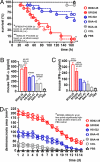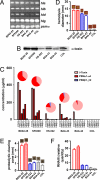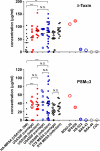Evolution of virulence in epidemic community-associated methicillin-resistant Staphylococcus aureus
- PMID: 19293374
- PMCID: PMC2667066
- DOI: 10.1073/pnas.0900743106
Evolution of virulence in epidemic community-associated methicillin-resistant Staphylococcus aureus
Abstract
Community-associated methicillin-resistant Staphylococcus aureus (CA-MRSA) has recently emerged worldwide. The United States, in particular, is experiencing a serious epidemic of CA-MRSA that is almost entirely caused by an extraordinarily infectious strain named USA300. However, the molecular determinants underlying the pathogenic success of CA-MRSA are mostly unknown. To gain insight into the evolution of the exceptional potential of USA300 to cause disease, we compared the phylogeny and virulence of USA300 with that of closely related MRSA clones. We discovered that the sublineage from which USA300 evolved is characterized by a phenotype of high virulence that is clearly distinct from other MRSA strains. Namely, USA300 and its progenitor, USA500, had high virulence in animal infection models and the capacity to evade innate host defense mechanisms. Furthermore, our results indicate that increased virulence in the USA300/USA500 sublineage is attributable to differential expression of core genome-encoded virulence determinants, such as phenol-soluble modulins and alpha-toxin. Notably, the fact that the virulence phenotype of USA300 was already established in its progenitor indicates that acquisition of mobile genetic elements has played a limited role in the evolution of USA300 virulence and points to a possibly different role of those elements. Thus, our results highlight the importance of differential gene expression in the evolution of USA300 virulence. This finding calls for a profound revision of our notion about CA-MRSA pathogenesis at the molecular level and has important implications for design of therapeutics directed against CA-MRSA.
Conflict of interest statement
The authors declare no conflict of interest.
Figures





References
-
- Klevens RM, et al. Invasive methicillin-resistant Staphylococcus aureus infections in the United States. J Am Med Assoc. 2007;298:1763–1771. - PubMed
-
- Moran GJ, et al. Methicillin-resistant S. aureus infections among patients in the emergency department. N Engl J Med. 2006;355:666–674. - PubMed
-
- Chambers HF. Community-associated MRSA—Resistance and virulence converge. N Engl J Med. 2005;352:1485–1487. - PubMed
Publication types
MeSH terms
Grants and funding
LinkOut - more resources
Full Text Sources
Other Literature Sources
Medical

